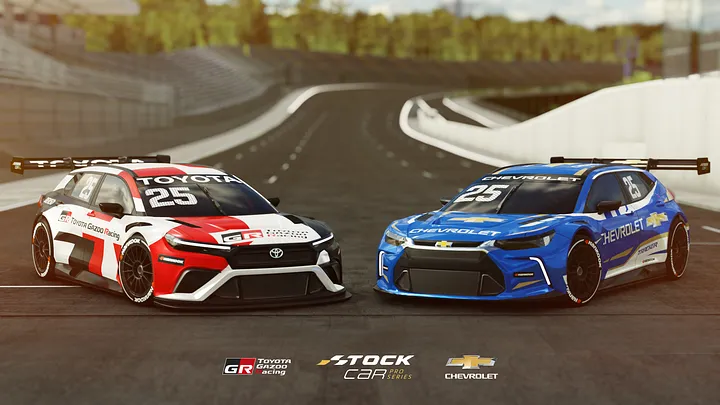SUVs — the future of touring car racing?
Touring car racing is one of the major motorsport categories where manufacturers build racing cars based on market-relevant models — that is, cars you can buy, park outside your home, drive around in —all with some useful extras like Bluetooth, DAB, cruise control, air conditioning, and three or more extra seats — but without some of the other perks like 400bhp engines, performance brakes, or MoTeC ECUs and data loggers.
In December 2023, the Stock Car Pro Series — Brazil’s leading tin-top category, has confirmed it’ll make a switch from its current model duo, the Toyota Corolla sedan and Chevrolet Cruze, to the Toyota Corolla Cross and Chevrolet Tracker in 2025.
The Cruze itself is in its second generation, but only available in South America, with sales of the model in Asia and North America having stopped some time ago. The model is now fairly old, having replaced the first-generation Cruze (which of course most of us know from its WTCC/BTCC days) nearly ten years ago.
The Corolla meanwhile is one of the most sold cars in the world, though the sedan is only available in certain markets. Europeans tend to favour the hatchback variant, though European tastes are also moving much more towards SUVs these days.
Of course it’s not just Europe, the trend away from saloons, then to hatches to SUVs is taking the world over, hence this decision, which the Stock Car Pro Series promoter says is due to the changing trend in the region.
So, will other series and categories follow suit? Will we see the BTCC soon adopt SUVs into its ‘next Next Generation’ regulations? After all, the Honda Civic Tourer didn’t really catch on did it?
Well, the estate, sorry, ‘Tourer’, was already a low volume seller — if they’d tried the HR-V maybe that would have made more sense, but also probably not — as there’s a big problem with SUVs — while they’re great for taking the kids to school and doing the shopping, they’re not so great at going around corners at high speed.
This leads you very quickly to the issue with the Stock Car project —as if you look at the artwork, their cars look like they’ll actually be pretty good at going around corners — and don’t really look much like SUVs at all. They have very low ride heights, and are almost just like a typical two-box hatchback.
This is because the Stock Car project is more a branding exercise — they’re not actually adopting the body shape of the road-going model for racing — the series only moved from an exaggerated ‘stock car’ look in 2020 to the more touring car-esque approach it has now with the Corolla and Cruze.
Effectively this is a series recognising it can make use of its generic platform to follow the market trend, at least in terms of badging, rather than wed itself to continuing to race models of cars from a diminishing segment, albeit ones that are far more suited to racing.
So this is where there is some disconnect between stock car racing and touring cars, and why it’ll be difficult for championships that run to BTCC, Supercars, and TCR regulations to make a similar kind of move — as high-stance SUVs are not good race cars.
In TCR, the trend in recent years has almost been to go the other way. While its first models were two-box performance hatchbacks such as the SEAT Leon and Honda Civic FK2, more recently three-box racing saloons such as the Lynk & Co 03, Hyundai Elantra, and Audi RS 3 have become the TCR mainstay, and the Civic itself has gravitated towards being a larger ‘saloon-like’ hatch (‘fastback’ seems to be the made up manufacturer lingo for it).
Mikel Azcona’s Hyundai Elantra (i30 Sedan) during the TCR World Tour event at Bathurst 2023. Photo: Daniel Kalisz/TCR Australia
The BTCC funnily enough went the other way — while NGTC (Next Generation Touring Car) was heralded as a return to saloon cars of the series’ ‘90s heyday, with the Toyota Avensis and Audi A4 among its early models — the flexibility of the platform has seen the teams quickly gravitate toward more UK-market relevant models such as Civics, Focuses, Corollas, Leons (as the three-box saloon has now all but been wiped out from UK showrooms, with only the premium German brands selling in this space).
Supercars, well, they have their own market relevancy issues — the SUV is fast becoming king over the fading saloon in Australia, and with the death of the Ford Falcon and the Holden Commodore in recent years, the championship has plugged the gap with the specialist sports car market Chevrolet Camaro and Ford Mustang, even though the Camaro is already at the end of its life.
All of these categories are built around using road models as their base for a large amount of components, most notably the shell — and so all are wedded to using racing-friendly models — be they saloons or hatchbacks. That leaves two options if they were to follow the SUV trend. One is to mandate a switch to using these very unraceable family SUV models as a base car within the technical regulations, which will make them very unfriendly to the important customer racing market, who’d likely much rather want to race a GT car instead. Or completely move to a silhouette platform that allows faux SUV names to be used in more sporty bodies (Ford Puma Rally1 anyone?).
With no appetite for either of those moves for now, the hatchback and saloons will likely still be around in touring car racing until the next big shift to electric racing.


